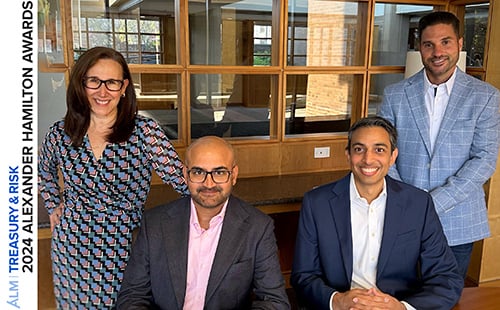
Earlier this year, when banks including Silicon Valley Bank, Signature Bank, and Credit Suisse collapsed, treasurers from various industries and regions faced a sudden urgent need to re-evaluate their exposures to risky financial institutions. They also needed to reallocate any deposits and banking business that were directly impacted by the institutions which had failed.
In many cases, organizations were able to quickly adjust their exposure to specific entities, sometimes down to the country level. And from a bird's-eye corporate perspective, the focus on counterparty risk—the risk that the other party in a transaction or relationship will fail to fulfill its contractual obligations—intensified, making counterparty risk management a more dynamic endeavor.
Recommended For You
Changing Perspective on Counterparty Risk
The rapid onset of the banking crisis, and its uneven impact on different institutions, brought about a shift in companies' perception of counterparty risk. The crisis taught us that deposit runs can occur with astonishing speed, causing circumstances to change overnight. The power of social media was also evident: Information quickly disseminated to a wide audience, amplifying both genuine and unfounded fears, which created their own potential risk. This accelerated chain of events highlighted the need for corporate treasury teams to swiftly adapt to our new reality.
Different companies adopted different strategies for responding to the banking crisis. Some organizations immediately moved available liquidity to overnight deposits with banks designated as globally systemically important banks (GSIBs) until the situation had stabilized. Others opted for government funds or short-dated money market funds (MMFs). Many conducted independent research on banks to determine which regulatory entity would serve as the lender of last resort in a crisis scenario. Even companies that didn't alter their immediate-term approach to counterparty risk management prepared for potential changes.
Sometimes the differences in strategy were dependent on the type of business involved. For instance, hedge funds tend to be very cautious because they're handling client money. As a result, some of them prefer short-term bonds and government securities. Similarly, consulting firms that are privately owned through a partnership structure may become more conservative at times of stress, opting for a flat structure that enables quick decision-making. Finally, public companies, which must be responsive to shareholders, are usually constrained by a need to pursue adequate yields. They have a greater ability to invest in a range of assets, so even when they move to a more conservative stance, they generally do not limit themselves to only government securities.
Four months after the start of the banking crisis, we know that the market can be very unpredictable. The question is how to continue managing counterparty risk in an environment in which rising interest rates are increasing demand for returns on excess liquidity.
How to Approach Counterparty Risk
Most treasurers' approaches to assessing counterparty risk rely on historical data. One option is to treat all banks involved in the organization's revolving credit facility as having the same level of risk allocation; another is to consider the tier within the credit facility when determining the risk the company faces vis-á-vis a particular institution. Treasury teams calculating counterparty risk may combine banks' credit ratings with market valuation indicators, such as a 30-day market valuation trend. However, to do so, they usually rely primarily on historical information.
Treasurers wanting to more dynamically manage counterparty credit risk need to look ahead and anticipate future exposures, not rely exclusively on data from the past. There are a few steps they can take to nurture the future-oriented mindset.
One key is to establish and maintain open lines of communication and to connect with counterparties on a regular basis. Similar to how individual depositors can monitor social media and quickly respond to problematic information by withdrawing funds, companies should take the initiative to check in with their relationship banks for general economic and credit risk updates. If any red flags or rumors arise, the organization should address them immediately, potentially pulling its deposits if the concerns are great enough. They may also try to establish which entity would be the counterparty's lender of last resort; the answer might vary by country. It is the responsibility of banks and financial institutions to stay vigilant about external developments, so they should be prepared to answer any questions transaction banking clients may have about events that may affect their creditworthiness or the security of customers' deposits.
Another step treasurers can take is to monitor credit default swap (CDS) spreads. This is an indicator of bank risk that has become more popular in predicting sudden market swings like we saw earlier this year. A credit default swap is a derivative that transfers the credit exposure of fixed-income products. A company's investment policy may already dictate how the treasurer should calculate counterparty limits for relationship banks. However, credit default swaps can serve as an immediate indicator of how risky the market considers an institution to be, which can help the treasurer monitor market movements more dynamically. For example, if a financial institution has one of the lowest credit default margins, it is generally perceived as posing lower risk. Treasurers should pay attention when a financial institution's CDS spreads start changing rapidly, especially when they become larger, indicating the risk is increasing.
It is also a good idea for treasurers to use modern cash forecasting technology instead of relying on data manually entered into Excel spreadsheets. Treasury systems that provide real-time balance and transaction information enable treasurers to quickly assess companywide exposure to a particular counterparty without the lag in reporting on balance levels that manual and spreadsheet-based tracking entail. Some treasury systems automatically determine counterparty exposure, and send an alert if necessary, when an institution on the other side of the world experiences issues and the treasury team is asleep.
Treasury groups may also want to update their daily reports on payables and receivables with real-time bank balance data. Doing so could enable them to better predict anticipated incoming payments and collections, with sensitivity given to stress situations such as the 2008 financial crisis, the pandemic, or the recent regional banking crisis.
The Counterparty Credit Tradeoff
Managing counterparty risk always involves a tradeoff. Treasurers can choose to maintain liquidity by placing all the company's cash in a government instrument, which will eliminate counterparty risk and ensure that the funds are always available but will also provide a minimal (if any) rate of return. Alternatively, treasurers can place all the company's cash with the banks they trust the most and push those institutions to offer the highest possible yields. This approach increases investment income but introduces exposure to those counterparties.
There are also situations in which treasury teams do not have easy access to the company's cash. Perhaps the investment policy established by the board limits how much cash they can have with their relationship banks in a certain region, such as China. In this case, the company may end up with a significant portion of its liquidity held by non-relationship banks, and it may be challenging to access that cash quickly.
Treasury teams have a particularly difficult time managing counterparty risk when the corporate investment policy lacks the flexibility to adapt to local market needs. Often, boards create investment policies to fit within a predefined framework, so the policies fail to sufficiently account for the unique dynamics of different markets where the company does business. To address this, boards should consider more flexible policies that incorporate regular review, such as requiring a reassessment of the counterparty credit risk policy every quarter.
The counterparty policy should allow treasurers the flexibility to make informed decisions promptly when confronted with swiftly changing risks. Furthermore, it is crucial to control the natural demand for increased yields on cash investments when interest rates are rising. This is essential to prevent additional complexities in liquidity management.
See also:
- Still Ignoring the Risks Inherent in Bank Deposits?
- Why Be Vulnerable?
- A Treasurer's Checklist for Navigating the Russia-Ukraine Conflict
- Model of Excellence in Financial Risk Management
- What Treasury Should Do to Be Prepared
 Karen Hom is a managing director and transaction banking team lead at Standard Chartered Bank. She has 25 years of banking experience across multiple geographies and client segments. She is currently managing the global cash management business for top U.S. multinational corporations across the industrials and oil-and-gas sectors, primarily in Asia, Africa, and the Middle East.
Karen Hom is a managing director and transaction banking team lead at Standard Chartered Bank. She has 25 years of banking experience across multiple geographies and client segments. She is currently managing the global cash management business for top U.S. multinational corporations across the industrials and oil-and-gas sectors, primarily in Asia, Africa, and the Middle East.
 Tarek El-Yafi is a managing director and regional head of cash management sales at Standard Chartered Bank, where he is head of Americas cash and trade sales. His team is responsible for helping clients across the Americas grow their businesses and operate efficient, market-leading cash management processes in Asia, Africa, and the Middle East. El-Yafi joined Standard Chartered in 2009; before that, he spent 13 years with Citibank in New York and Texas in senior product management, sales, and relationship management roles.
Tarek El-Yafi is a managing director and regional head of cash management sales at Standard Chartered Bank, where he is head of Americas cash and trade sales. His team is responsible for helping clients across the Americas grow their businesses and operate efficient, market-leading cash management processes in Asia, Africa, and the Middle East. El-Yafi joined Standard Chartered in 2009; before that, he spent 13 years with Citibank in New York and Texas in senior product management, sales, and relationship management roles.
© Touchpoint Markets, All Rights Reserved. Request academic re-use from www.copyright.com. All other uses, submit a request to [email protected]. For more inforrmation visit Asset & Logo Licensing.



